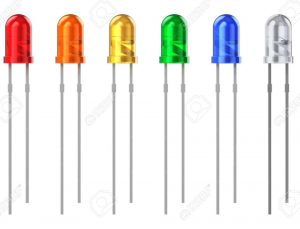Question 1 Write the full form of LED?
Question 2 Name a device which glows even when a weak electric current passes through it?
Question 3 What is it advantage of using LED in testing the electrical conductivity of liquids?
Question 4 Which effect of electric current is utilised for detecting the flow of current through a solution:
(a) When a torch bulb is used
(b) When a compass is used
Question 5 What happens to the needle of a compass kept nearby when electric current is switched on in a wire? Why does this happen?
Question 6 Why does an electric bulb glow when a current passes through it?
The current flowing in a circuit is usually detected by using a small electric bulb.
When an electric current flows through a bulb then due to the heating effect of current, the filament of bulb gets heated to a high temperature, becomes white hot and glows to produce light.
When the current flowing through a circuit is large, the heating effect is large due to which the bulb glows brightly.
When the current flowing through the circuit is small, the heating effect is also small, due to which the bulb glows dimly. If the current flowing through the circuit is too weak, then the heating effect produced by current in the filament is too little, due to which the filament does not get heated sufficiently and hence the bulb does not glow at all.
A torch bulb cannot be used to detect weak electric current flowing through a liquid in the circuit.
The weak electric current flowing through liquids can be detected in two ways:
(1) By using a LED that is light emitting diode
(2) By using a compass
LED is a semiconductor device which glows even when a week current passes through it. There are two wires called leads attached to an LED. One lead is slightly longer than the other. While connecting LED in the circuit, the longer head is always connected to the positive terminal of the battery and the shorter leg is connected to the negative terminal of the battery.
We can also detect weak electric current flowing through a liquid by using a compass. We take out the cardboard tray from the inside of a discarded matchbox. Place a small compass inside this cardboard tray. Wrap an electric wire a few times around the cardboard tray so as to make a type of coil of wire around the compass. The match box tray containing the compass inside it and having wound up wire around it is connected in place of torch bulb in the circuit of the liquid to be tested for conductivity.
If a weak electric current flows through the liquid in the circuit the magnetic needle of compass will show deflection. This is because even a weak electric current flowing through a wire produces a magnetic field around it. And this magnetic field of electric current acts on the magnetic needle of the compass and deflect it from its usual north south position. If a compass surrounded by wound of electric wire of a circuit including a liquid in it shows deflection, it will mean that the liquid conduct electricity.
In order to detect the electrical conductivity of a liquid, the two ends of wires are connected at a place in the circuit where the two terminals of a torch bulb are normally connected.
(1) Liquid such as vinegar, lemon juice, tap water, rain water and sea water are included in the circuit, a deflection in the magnetic needle of compass is observed. This shows that vinegar, lemon juice, tap water, rain water and see water are conductors of electricity.
(2) When liquids like distilled water, milk, vegetable oil and honey are included in the circuit, no deflection is observed in the magnetic needle of compass .This shows that the liquid such as distilled water, milk, vegetable oil and honey are poor conductors of electricity.
Most of the liquids that conduct electricity are solutions of acids, bases and salt because the solution of acids, bases and salts contain charged particles called ions which conduct electricity through these solutions.

Leave a Reply